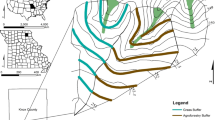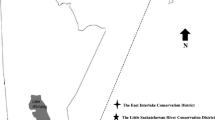Abstract
The scientific research literature is reviewed (i) for evidence of how much reduction in nonpoint source pollution can be achieved by installing buffers on crop land, (ii) to summarize important factors that can affect this response, and (iii) to identify remaining major information gaps that limit our ability to make probable estimates. This review is intended to clarify the current scientific foundation of the USDA and similar buffer programs designed in part for water pollution abatement and to highlight important research needs.
At this time, research reports are lacking that quantify a change in pollutant amounts (concentration and/or load) in streams or lakes in response to converting portions of cropped land to buffers. Most evidence that such a change should occur is indirect, coming from site-scale studies of individual functions of buffers that act to retain pollutants from runoff: (1) reduce surface runoff from fields, (2) filter surface runoff from fields, (3) filter groundwater runoff from fields, (4) reduce bank erosion, and (5) filter stream water. The term filter is used here to encompass the range of specific processes that act to reduce pollutant amounts in runoff flow.
A consensus of experimental research on functions of buffers clearly shows that they can substantially limit sediment runoff from fields, retain sediment and sediment-bound pollutants from surface runoff, and remove nitrate N from groundwater runoff. Less certain is the magnitude of these functions compared to the cultivated crop condition that buffers would replace within the context of buffer installation programs. Other evidence suggests that buffer installation can substantially reduce bank erosion sources of sediment under certain circumstances. Studies have yet to address the degree to which buffer installation can enhance channel processes that remove pollutants from stream flow.
Mathematical models offer an alternative way to develop estimates for water quality changes in response to buffer installation. Numerous site conditions and buffer design factors have been identified that can determine the magnitude of each buffer function. Accurate models must be able to account for and integrate these functions and factors over whole watersheds. At this time, only pollutant runoff and surface filtration functions have been modeled to this extent. Capability is increasing as research data is produced, models become more comprehensive, and new techniques provide means to describe variable conditions across watersheds.
A great deal of professional judgment is still required to extrapolate current knowledge of buffer functions into broadly accurate estimates of water pollution abatement in response to buffer installation on crop land. Much important research remains to be done to improve this capability. The greatest need is to produce direct quantitative evidence of this response. Such data would confirm the hypothesis and enable direct testing of watershed-scale prediction models as they become available. Further study of individual pollution control functions is also needed, particularly to generate comparative evidence for how much they can be manipulated through buffer installation and management.
Similar content being viewed by others
Author information
Authors and Affiliations
Rights and permissions
About this article
Cite this article
Dosskey, M. Toward Quantifying Water Pollution Abatement in Response to Installing Buffers on Crop Land. Environmental Management 28, 577–598 (2001). https://doi.org/10.1007/s002670010245
Issue Date:
DOI: https://doi.org/10.1007/s002670010245




